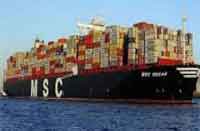| |
|
| |
|
 |
Supply
Chain by the Numbers |
| |
|
| |
- Oct. 17, 2019 -
|
| |
|
| |
|
| |
|
| |
US Manufacturing Output is Wobbly; IMF Takes Global Growth Forecasts Down; Nike Dramaticaly Changing Its Distribution Strategy; MSC Says Full Speed Ahead for More Megaships |
| |
|
| |
| |
| |
| |
104.8 |
|
That was the level of US manufacturing output in September, according the monthly index from the Federal Reserve. That was down 0.5% from August, but the report said much of that can be blamed on the strike at GM. Excluding motor vehicles and parts, the overall index and the manufacturing index each moved down 0.2%. While obviously not good news, the results indicate a modest slowdown in manufacturing activity, but not a major dive, as some have feared, with talks of a "manufacturing recession." Output was actually up 1.1% in Q3. The index was also down 0.5% from September of 2018. However, the index has basically been flat for all of 2019. And at a value of 104.8, it means production now is just 4.8% above the average month in the baseline yeat of 2012 - meaning annual gains of well less than 1%. Factory utilization Capacity utilization for manufacturing decreased 0.4 percentage point to 75.3% in September, a rate that is 3.0 percentage points below its long-run average.
|
|
|
| |
| |
|
|
|
That's the year athletic apparel giant Nike plans to reduce to almost nothing the number of smaller retail chains it will sell to. The company explained that sales of this channel were no longer in line with Nike's distribution strategy, according to a report in the UKs The Sunday Times. Nike actually started this strategy back in 2017, when it announced that it planned to reduce its presence in small stores and independent retailers. The goal is to increase its profits and margins by eliminating intermediaries, reducing independent retailers' promotions and control its distribution strategy. That means focusing on only the largest retailers and its own growing consumer direct business. With the consumers' direct offense plan, the goal of the company is to "speed up innovation, producing and getting products to consumers faster and selling to and engaging with consumers more directly through digital channels," stated the company. The world is changing very rapidly indeed. |
| |
| |
|
| |
| |
$762 Million |
 |
That is how much ocean container carrier Mediterranean Shipping Co. is spending to receive five new megaships It was not immediately clear if the vessels are new orders or options on an 11-ship order that MSC made in 2017. The other six ships, all in the 23,000-TEU range, are being built at Korea's Samsung Heavy Industries, with the last expected to be delivered by the first quarter of 2020. The move shows that carriers are committed to an operating model built on economies of scale, despite many saying the ships are too big to be efficient. The unit-cost advantages for the new generation megaships are compelling – on paper. But the cost advantages disappear if the ships are not full, and faltering global trade isn't cooperating with the container lines' financial plans. Freight rates on the big Asia-Europe lanes are at the lowest levels in three years. MSC will see its total capacity increase just over 6% through 2021 with the new fleet additions, much faster than global container volume growth.
|
| |
| |
| |
| |
| |
|
|
|
| |
 |
 |
| |
|
|
| |